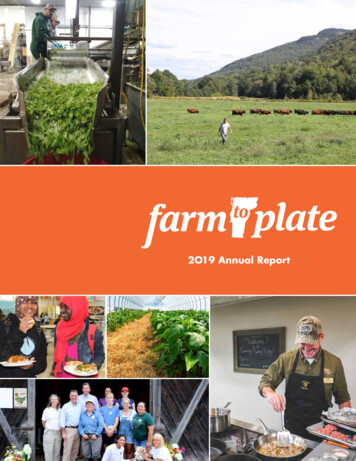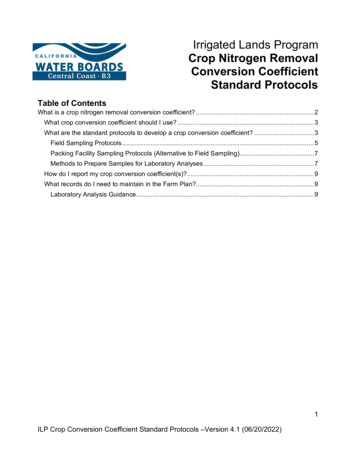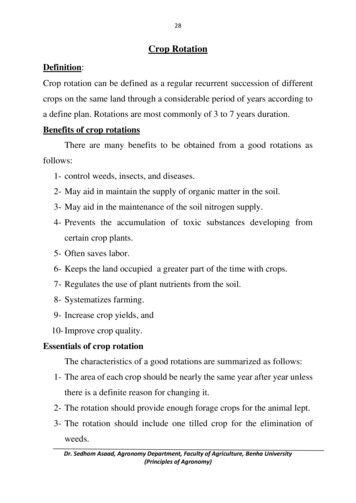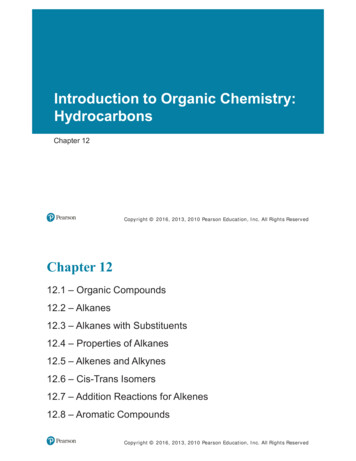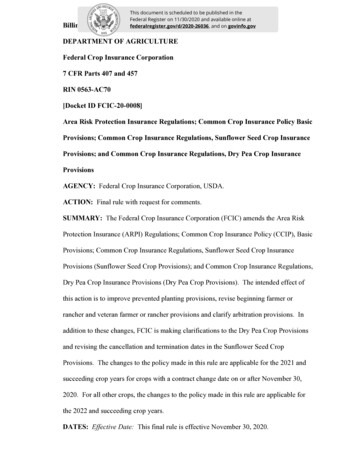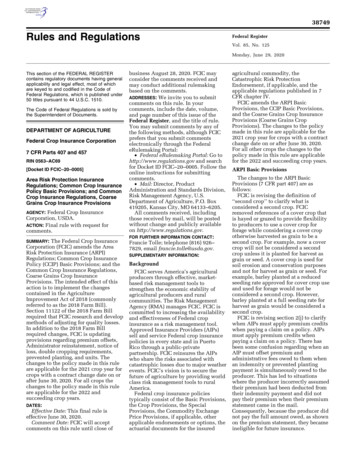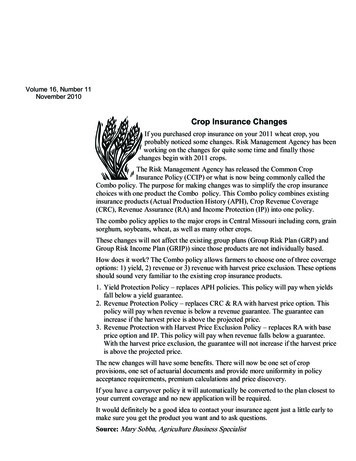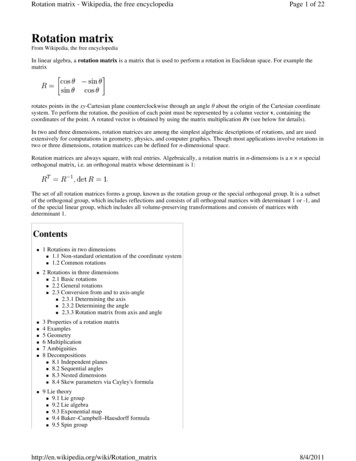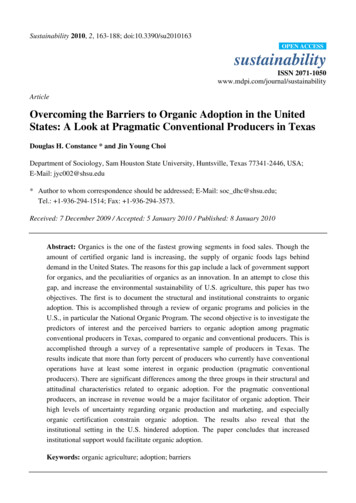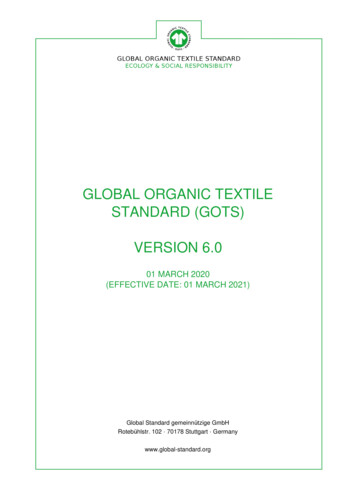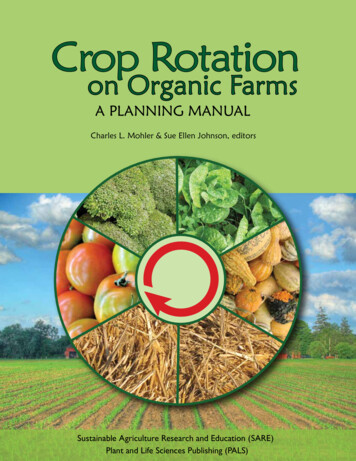
Transcription
Crop Rotationon Organic FarmsA PLANNING MANUALCharles L. Mohler & Sue Ellen Johnson, editorsSustainable Agriculture Research and Education (SARE)Plant and Life Sciences Publishing (PALS)
CROP ROTATION ON ORGANIC FARMSa planning manualCharles L. MohlerandSue Ellen Johnson,editorsPublished by the Sustainable Agriculture Research and Education (SARE) program.SARE is supported by the National Institute of Food and Agriculture, U.S. Deparmentof Agriculture. Formerly published by Plant and Life Sciences Publishing (PALS).NRAES-177
Published July 2009 (NRAES-177)Reprinted 2020This book was first published in 2009 by the Natural Resource, Agriculture, and Engineering Service (NRAES).As of 2020 it is published by the Sustainable Agriculture Research and Education (SARE) program. SARE issupported by the USDA’s National Institute of Food and Agriculture under award No. 2019-38640-29881. Learnmore about NRAES and SARE on pages 155-156.ISBN 978-1-933395-21-0Library of Congress Cataloging-in-Publication DataCrop rotation on organic farms : a planning manual / Charles L. Mohler and Sue Ellen Johnson, editors.p. cm. -- (Cooperative Extension NRAES ; 177)Includes bibliographical references and index.ISBN 978-1-933395-21-01. Crop rotation--Handbooks, manuals, etc. 2. Organic farming--Handbooks, manuals, etc. I. Mohler,Charles L., date II. Johnson, Sue Ellen, date III. Natural Resource, Agriculture, and Engineering Service.Cooperative Extension. IV. Series: NRAES (Series) ; 177.S603.C756 2009631.5’82--dc22200901605DisclaimerThe SARE program provides information to everyone, without regard to race, religion, national origin, sex, age,disability, familial or veteran status. Every effort has been made to make this publication as complete and asaccurate as possible. It is only a guide, however, and should be used in conjunction with other informationsources. The editors/authors and publisher disclaim any liability, loss or risk, personal or otherwise, which isincurred as a consequence, directly or indirectly, of the use and application of any if the contents of thispublication. Any opinions, findings, conclusions or recommendations expressed in this publication are those ofthe authors and do not necessarily reflect the view of the USDA or SARE.Ordering informationFor online orders visit www.sare.org/webstore. Call (301) 779-1007 to order by phone with credit card payment.To pay by check or purchase order, make payable to Sustainable Agriculture Publications and send to:SARE Outreach Publicationsc/o International Fulfillment Corporation3570 Bladensburg Rd.Brentwood, MD 20722Cost: 24 for orders of 1-9 books 18 for 10-24 books (a 25% discount) 12 for 25 or more books (a 50% discount)Shipping: 6.95 for first book (within the United States). Add 2 s/h for each additional book—up to nine books—shippedwithin the United States. For s/h on orders of 10 or more books, call (301) 779-1007 or visit www.sare.org/WebStore.International orders:Call (301) 779-1007 or visit www.sare.org/WebStore.ii
CONTENTSAcknowledgments . vAbout the Authors . .viChapter 1: Introduction . . 1Charles L. MohlerHow This Manual Was Constructed . . 2How to Use This Manual 2Chapter 2: How Expert Organic Farmers Manage Crop Rotations 3Sue Ellen Johnson and Eric ToensmeierWhy Rotate Crops? 3Basics of Crop Rotation 5Crop Rotation and Farm Management . . 6The NEON “Managing a Crop Rotation System” Chart . 9Key Responsibilities and Related Tasks in the Chart .10Chapter 3: Physical and Biological Processes in Crop Rotation . . 21What This Chapter Is About . 21Charles L. MohlerCrop Rotation and Soil Tilth . . 23Harold van EsCrop Rotation Effects on Soil Fertility and Plant Nutrition . . . 27Anusuya RangarajanManaging Plant Diseases with Crop Rotation . 32Margaret Tuttle McGrathManagement of Insect Pests with Crop Rotation and Field Layout . 41Kimberly A. StonerThe Role of Crop Rotation in Weed Management . . . .44Charles L. MohlerChapter 4: Crop Sequences from Expert Farmers’ Fields . . 47Sue Ellen JohnsonReading the “Real Fields on Real Farms” Tables . 47Observation on the Sample Sequences . . 56Summary . 57iii
Chapter 5: A Crop Rotation Planning Procedure . . 58Charles L. MohlerTips for Sequencing Crops . . 59A Complete, Step-by-Step Rotation Planning Guide . 69A More Complex Example: Summer Acres Vegetable Farm 83Chapter 6: Crop Rotation during the Transition fromConventional to Organic Agriculture . . 91Charles L. MohlerTransition from Old Sod to Vegetable Production . 91Transition from Conventional Cropping on a Farm with Forages . 92Transition to Cash Grain or Vegetables on a Farm without Forages . . .93Chapter 7: Guidelines for Intercropping .95Charles L. Mohler and Kimberly A. StonerInterplanting Crops with Partially Overlapping Growing Seasons .96Intercropping Legumes with Nonlegumes . .96Using Tall Crops to Reduce Drought or Heat Stress of Shorter Crops . .96Using Intercropping to Disrupt Host Finding by Some Host-Specific Insect Pests .98How Intercrops Affect Populations of Beneficial Parasitoids and Pest Predators .99Using Trap Crops to Reduce Pests . .99A Glossary of Intercropping Terms .100Appendix 1: Characteristics of Crops Commonly Grown in the Northeastern United States.101Charles L. Mohler and Anusuya RangarajanAppendix 2: Crop Sequence Problems and Opportunities . 104Charles L. MohlerAppendix 3: Sources of Inoculum for Crop Diseases in the Northeastern United States .124Margaret Tuttle McGrathAppendix 4: Characteristics of Common Agricultural Weeds Relevant to Crop Rotation. 138Charles L. MohlerAppendix 5: Crop Disease Pathogens Hosted by Common Agricultural Weeds . .142Charles L. Mohler and Margaret Tuttle McGrathAppendix 6: Linking a Field Map and Spreadsheet in Microsoft Excel .148Jody Bolluyt, Peter Lowy, and Charles L. MohlerReferences . .150About SARE . 155About PALS. 156iv
ACKNOWLEDGMENTSProduction of Crop Rotation on Organic Farms: A Planning Manual was made possible withfunding from Sustainable Agriculture Research and Education (SARE). See page 155 for moreinformation about SARE.This project was a collaboration between researchers, extension educators, and growers. Theauthors especially thank the twelve farmers who participated in the DACUM process, and whoseefforts created the foundation for this project: Polly Amour, Four Winds Farm, Gardiner, NY; PaulArnold, Pleasant Valley Farm, Argyle, NY; David Blyn, Riverbank Farm, Roxbury, CT; Roy Brubaker,Village Acres Farm, Mifflintown, PA; Jean-Paul Courtens, Roxbury Farm, Kinderhook, NY; JimGerritsen, Wood Prairie Farm, Bridgewater, ME; Brett Grohsgal, Even Star Organic Farm, LexingtonPark, MD; Jack Gurley, Calvert’s Gift Farm, Sparks, MD; Don Kretschmann, Kretschmann Farm,Rochester, PA; Drew Norman, One Straw Farm, White Hall, MD; Eero Ruuttila, Nesenkeag Farm,Litchfield, NH; and Will Stevens, Golden Russet Farm, Shoreham, VT. Tina Overtoom, The Centeron Education and Training for Employment, The Ohio State University, was the DACUM facilitator,and Eric Toensmeier, then with the New England Small Farm Institute, assisted her. Many additionalgrowers reviewed and verified the DACUM chart: Frank Albani, Jay Armour, Mike and TerraBrownback, Judy Dornstreitch, Pam Flory, Darrell Frey, Les and Debbie Guile, Rick Hood, JasonKafka, Dwain Livengood, Bryan O’Hara, Robin Ostfeld, L. Smith, Ed Stockman, Paul Volcklawen,and several anonymous reviewers.The authors also thank the following reviewers for the many improvements they suggested:Brian Caldwell, farm education coordinator, NOFA-NY; Kathryne L. Everts, associate professor,Plant Pathology, University of Maryland and University of Delaware; Caragh B. Fitzgerald, extensioneducator, Maryland Cooperative Extension; Eric Gallandt, assistant professor, Weed Ecology andManagement, University of Maine; Vern Grubinger, vegetable and berry specialist, University ofVermont Extension and regional coordinator, Northeast SARE; Jerzy Nowak, professor, HorticultureDepartment, Virginia Polytechnic Institute and State University; Ginny Rozenkranz, extensioneducator, Maryland Cooperative Extension; Elsa Sanchez, assistant professor, Horticulture SystemsManagement, The Pennsylvania State University; Abby Seaman, senior extension associate, CornellCooperative Extension; Eric Sideman, organic crop specialist, Maine Organic Farmers & GardenersAssociation; Eric Toensmeier; and growers Polly Amour; Kurt Forman, Clearview Farm, Palmyra, NY;Brett Grohsgal; Jack Gurley; Brett Kreher, Kreher’s Poultry Farms, Clarence, NY; Don Kreher, Kreher’sPoultry Farms, Clarence, NY; Will Stevens; and Jon Thorne, Anchor Run Farm, Wrightstown, PA.Additionally, the authors are grateful to Steve Gilman, Ruckytucks Farm, Saratoga, NY; DaveColson, New Leaf Farm, Durham, ME; and Andy Caruso, Upper Forty Farm, Cromwell, CT forpatiently working through early versions of the planning procedure. Steve Vanek, PhD candidate,Cornell University; Brian Caldwell; and Steve Gilman assembled the information for several ofthe crop rotation examples in Chapter 4. Klaas and Mary Howell Martens, Lakeview OrganicGrains, Penn Yan, NY; John Myer, Myer Farm, Ovid, NY; Edwin Fry, Fair Hills Farm, Chestertown, MD;and Eric and Anne Nordell, Beech Grove Farm, Trout Run, PA assisted in the study of their farms.Cornell University students Jennifer Rodriguez, Hui Ouyong, Erin Finan, Danya Glabau, and SamuelGreenwood helped assemble information for the tables. Anusuya Rangarajan, senior extensionassociate, Cornell University, provided gentle and joyful guidance of the NEON project.The book was edited by Jill Mason, MasonEdit.com and designed by Yen Chiang, NRAES. MartySailus, NRAES Director, managed book production from manuscript peer review through printing.Holly Hyde, editor, provided production support. Additional production support was providedViolet Stone, Cornell University Department of Horticulture.Support for this project was provided through a grant from the USDA Initiative for FutureAgriculture and Food Systems; and Hatch funds (Regional Project NE-1000, NY(C)–183458) from theCornell Agricultural Experiment Station.v
About the Authors(listed in alphabetical order)Jody Bolluyt, producer, Roxbury Farm, Kinderhook, New YorkSue Ellen Johnson, research leader, New England Small Farm Institute, Belchertown,Massachusetts; currently assistant professor and forage specialist, Department of CropScience, North Carolina State UniversityPeter Lowy, intern, Roxbury Farm, Kinderhook, New YorkMargaret Tuttle McGrath, associate professor, Department of Plant Pathology, Long IslandHorticultural Research Laboratory, Cornell UniversityCharles L. Mohler, senior research associate, Department of Crop and Soil Sciences,Cornell UniversityAnusuya Rangarajan, senior extension associate, Department of Horticulture, CornellUniversityKimberly A. Stoner, associate agricultural scientist (entomology), The ConnecticutAgricultural Experiment Station, New Haven, ConnecticutEric Toensmeier, program specialist, New England Small Farm Institute, Belchertown,Massachusetts; currently farm project director, Nuestras Raices, Holyoke, MassachusettsHarold van Es, professor and chair, Department of Crop and Soil Sciences, CornellUniversityvi
1INTRODUCTIONCharles L. MohlerCrop rotation is a critical feature of all organiccropping systems because it provides the principal mechanism for building healthy soils, a majorway to control pests, and a variety of other benefits. Croprotation means changing the type of crop grown on a particular piece of land from year to year. As used in this manual, the term includes both cyclical rotations, in whichthe same sequence of crops is repeated indefinitely on afield, and noncyclical rotations, in which the sequence ofcrops varies irregularly to meet the evolving business andmanagement goals of the farmer. Each field has its ownrotation, and, consequently, each farmer manages a set ofrotations.Good crop rotation requires long-term strategic planning. However, planning does not necessarily involveidentifying which crop will be grown on a field years inadvance. Indeed, such specificity may prove futile as plansbecome disrupted by weather, changes in the market, labor supply, and other factors. Lack of planning, however,can lead to serious problems—for example, the buildupof a soilborne disease of a critical crop, or imbalances insoil nutrients. Such problems can result in an inability tomeet the demands of a carefully cultivated market or inadditional labor and expense. Problems caused by faultyrotation often take several years to develop and can catcheven experienced growers by surprise. In fact, rotationproblems usually do not develop until well after the transition to organic cropping. Since the crops grown by organicfarmers are often different and more diverse than thosegrown in the preceding conventional system, the organictransition itself often rotates away from the previous cropsand their associated problems. Most farmers are greatlytempted to plant excessive acreage of the most profitablecrop or to overuse certain fields for one type of crop. Suchpractices can lead to costly problems that take many years“The purpose of this bookis to help growers andfarm advisors understandthe management of croprotations; avoid crop rotationproblems; and use croprotation to build better soil,control pests, and developprofitable farms that supportsatisfied families.”to correct. The purpose of this book is to help growers andfarm advisors understand the management of crop rotations; avoid crop rotation problems; and use crop rotationto build better soil, control pests, and develop profitablefarms that support satisfied families.Although rotating among a diversity of cash and cover crops has numerous advantages, it poses substantialmanagement challenges. The number of crops (and cropfamilies) grown can be large, particularly on diversifiedvegetable farms and mixed vegetable-grain operations.Mathematically, this creates a huge number of potentialcrop sequences from which to choose. For example, if afarm produces ten different crops, these can be arrangedin 90 two-year sequences, since each of the ten cropscould be followed by any of the other nine. The same tencrops can be arranged in any of 5,040 unique four-year sequences! Of course, some sequences can be easily eliminated from the list of possibilities, based on experienceCHAPTER 1 Introduction1
or general rules of thumb, like avoiding successive vegetable crops in the same plant family, but the number ofpossibilities is still enormous. Further complications arisebecause, for market reasons, some crops are grown on alarger acreage than others. Large-acreage crops necessarily occur in multiple sequences with different small acreage crops. Moreover, since certain crops grow well onlyon particular fields due to soil type, availability of irrigation, topography, etc., the problem of choosing effectivecrop sequences and allotting them to particular fields becomes even more complex.This manual is intended to assist growers in plotting acourse through the maze of decisions involved in planningcrop rotations. The idea behind the manual is not toprovide a list of rigid dos and don’ts. Rather, the intent isto provide perspectives on how to approach the challengeof planning effective crop rotations and to provide currentinformation on which to base decisions.How This Manual WasConstructedTo ensure that this rotation planning manual reflectsthe realities of crop production on actual farms, the NewEngland Small Farm Institute, on behalf of the NortheastOrganic Network (NEON), assembled a panel of 12 expert organic farmers. The panel met for three days andworked through a formal facilitated process that produceda detailed analysis of how experienced organic farmersplan their cropping sequences. This process is discussedin chapter 2 (pages 3–20). Each expert farmer also detailed a highly successful crop rotation that they use, alongwith problems that sometimes occur with that rotationand how they meet such contingencies. These sample rotations are presented in chapter 4 (pages 47–57) and aresupplemented with rotations from several farms that havebeen intensively studied by NEON. These sample rotations may not work well on farms that have different soilconditions, climates, financial resources, or types of crops,but they are intended to provide inspiration and insight inplanning crop sequences.Chapters 2 (pages 3–20) and 4 (pages 47–47) conveythe practical experience of expert growers. In contrast, chapter 3 (pages 21–46) emphasizes the theoretical underpinnings of crop rotation. Five researchers who have extensiveexperience with organic agriculture provide their views onwhat crop rotation contributes to particular biological and2Crop Rotation on Organic Farms: A Planning Manualphysical aspects of organic cropping systems, includingmanagement of soil health, crop nutrition, diseases, insects,and weeds. An important aspect of these contributions isthat they clarify what crop rotation cannot accomplish, aswell as what it can do to solve various production problems.Chapter 5 (pages 58–90) outlines procedures forsorting through the diverse types of data to arrive atdecisions about crop rotation. These procedures distillthe wisdom derived from the panel of expert growers intoa method that can be applied to any farm. Step-by-stepexamples are provided.Although this manual is primarily intended for organic farmers and the extension personnel who work withthem, we hope it will also be useful to other growers. Tothis end, chapter 6 (pages 91–94) provides a brief discussion about crop sequences that can be used for transitionfrom conventional to organic production.Intercropping is not a necessary part of crop rotation,but intercropping greatly affects crop rotation planning.Consequently, chapter 7 (pages 95–100) discusses thebasic principles of intercropping and how these interactwith other aspects of crop rotation.Finally, a series of appendices provide biological datarelevant to planning crop rotations. These data have beenassembled from a variety of sources, including scientificliterature, extension publications, and farmer experience.This manual is most applicable for farms from Maryland to Ohio and north through southern Canada. Most ofthe principles of crop rotation and methods for choosingamong potential crop sequences are widely applicable beyond this region. Data tables on crops, weeds, insects, anddiseases, however, are likely to be inadequate in areas farfrom the northeastern US.How to Use This ManualThis manual can be used in several ways. First, it canbe used simply as a reference. For example, one can checkfor possible pest or soil problems that may occur in acropping sequence, or determine how long to leave a fieldout of a particular crop to avoid pest problems. Second, themanual can be used to see how experienced growers thinkabout crop rotations, and how they manage particular cropsequences on their farms. Reading about what researchershave discovered about how crop rotation affects soil andpests will further increase one’s understanding of croprotations. Finally, the manual provides a method forsystematically planning the crop rotations on a farm.
2HOW EXPERT ORGANIC FARMERSMANAGE CROP ROTATIONSSue Ellen Johnson & Eric ToensmeierCrop rotation is central to the success of organicfarms. So how do successful farmers plan andexecute crop rotations?We asked twelve expert organic farmers this question when they gathered at a farmhouse in upstate NewYork for three snowy days in 2002. Between homemadeorganic meals, they detailed how they plan and executecrop rotations on their farms. The expert farmers, whotogether have over 200 years of experience, shared manyconcepts and insights about crop rotation management.Twenty other organic growers have since reviewed andadded to the panel farmers’ conclusions. Their cumulative knowledge and common practice are summarized inthis chapter. Their specific actions and decisions related tocrop rotation are outlined in the chart “Managing a CropRotation System” on pages 12–13. The chart delineates thekey “responsibilities” and the necessary “tasks” that needto be executed to fulfill each key responsibility.Why Rotate Crops?Effective crop rotations are a foundation of organiccropping systems. Organic farmers recognize that croprotation is necessary to maintain field productivity. Expertfarmers design their rotations to (1) earn income and (2)increase soil quality or build “soil capital” (sidebar 2.1).Crop rotation and a crop rotation plan and records arerequired for organic certification of a field or farm.Numerous books and articles outline the goals andbenefits of crop rotations (see sidebar 2.2, page 4). Thecontribution of our panel of expert farmers is interestingin (1) the emphasis they give to business management decisions in crop rotation planning; and (2) the flexibilityof their crop rotations, specifically the absence of fixed,long-term crop rotations. Their rotation planning is anongoing annual process that incorporates informationand objectives for multiple years. Many expert farmers donot have standardized, cyclical crop rotations for everyfield, yet our experts share an overall approach to designing, implementing, and adapting crop sequences on theirfarms. The tools in chapter 5 (pages 58–90) are designedto help readers develop their own expertise.Sidebar 2.1The Concepts of SoilQuality, Soil Capital, SoilHealth, and Soil LifeThe expert farmers used many terms interchangeably as they discussed rotations and theirfarm goals. Organic agriculture revolves aroundthe concepts of soil life and soil biology. Organicpractices, including crop rotation, are expectedto enhance soil life and soil health. A basic tenetof organic agriculture is that biological diversityand soil organic matter are drivers of productiveorganic farming systems. Farmers believe thata soil high in organic matter leads to a healthy,biologically active soil that will have fewer cropfertility, pest, and disease problems. Farmersalso use the term soil capital to express how soilbuilding practices are an investment in longterm soil productivity.CHAPTER 2 How Expert Organic Farmers Manage Crop Rotations3
Sidebar 2.2What Some Good Books Say about Crop RotationNumerous books and articles do an excellent job of outlining rotation theory, guidelines, and practice. Manypresent crop-by-crop rotations. These may or may not reflect the real complexity of modern organic farmingoperations and successful farm management, but a sampling of the advice is listed below.From Cyclopedia of American Agriculture (1907; L. H. Bailey, ed.), chapter 5, “Crop Management,” pp. 85–88:a. The rotation must adapt itself to the farmers business.b. It must adapt itself to the soil and fertility problem.c. The fertilizer question often modifies the rotation.d. The kind of soil and the climate may dictate the rotation.e. The labor supply has an important bearing on the character of the rotation course.f. The size of the farm and whether land can be used for pasturage are also determinants.g. The rotation must be planned with reference to the species of plants that will best serve one another, or produce thebest interrelationship possible.h. The rotation must consider in what condition one crop will leave the soil for the succeeding crop, and how one crop canbe seeded with another crop.From Organic Farming (1990; Nicolas Lampkin), chapter 5, “Rotation Design for Organic Systems,” pp. 131–32:“Usually a rotation contains at least one ‘money crop’ that finds a direct and ready market; one clean tilled crop; one hay orstraw crop; one leguminous crop. . . .The starting point for the design of a rotation should be the capabilities of the farm and the land in terms of soil type, soiltexture, climatic conditions.”Basic guidelines:Deep rooting crops should follow shallow rooting crops. . . .Alternate between crops with high and low root biomass. . . .Nitrogen fixing crops should alternate with nitrogen demanding crops. . . .Wherever possible, catch crops, green manures, and undersowing techniques should be used to keep the soil covered. . . .Crops which develop slowly and are therefore susceptible to weeds should follow weed suppressing crops. . . .Alternate between leaf and straw crops. . . .Where a risk of disease or soil borne pest problems exists, potential host crops should only occur in the rotation atappropriate time intervals. . . .Use variety and crop mixtures when possible. . . .Alternate between autumn and spring sown crops. . . .Also consider:suitability of individual crops with respect to climate and soilbalance between cash and forage cropsseasonal labour requirements and availabilitycultivation and tillage operationsFrom Building Soils for Better Crops (2000; Fred Magdoff and Harold van Es), chapter 11, “Crop Rotation,” pp. 102–3:General Principles:1. Follow a legume crop . . . with a high nitrogen demanding crop.2. Grow less nitrogen demanding crops . . . in the second or third year after a legume sod.3. Grow the same annual crop for only one year . . . .4. Don’t follow one crop with another closely related species. . . .5. Use crop sequences that promote healthier crops.6. Use crop sequences that aid in controlling weeds.7. Use longer periods of perennial crops on sloping land.8. Try to grow a deep-rooted crop . . . as part of the rotation.9. Grow some crops that will leave a significant amount of residue.10. When growing a wide mix of crops . . . try grouping into blocks according to plant family, timing of crops, (all earlyseason crops together, for example), type of crop (root vs. fruit vs. leaf), or crops with similar cultural practices. . . .4Crop Rotation on Organic Farms: A Planning Manual
Basics of Crop RotationRotations are one dimension of the art and scienceof farm management. The biological principles of croprotation intersect with many other aspects of the farmoperation and farm business. Crop rotation is both aprinciple of production and a tool of management (seesidebar 2.3). Expert farmers balance market options andfield biology. Labor, equipment, the layout of beds andfields, along with other logistics of planting and harvest,all influence how rotations are designed and executed.Expert farmers’ rotations include key cash crops,“filler” or “break” crops, and cover crops. In every season,farmers must manage production across multiple fieldsand beds. Variation in the acreage of each crop, variationin field characteristics, and shifting business decisionsresult in multiple rotations or crop sequences on mostorganic farms. Consequently, farmers manage numerouscrop rotations on the same farm.“Model” rotations may suggest that every crop isgrown on a fixed schedule on every field, with each croprotating field to field around the entire farm. In reality, expert farmers in the northeast US rarely cycle every cropthey grow through every field on any regular schedule. Instead, each field tends to have its own distinct sequenceof crops, tillage, and amendments. Thus, each field tendsto have a unique cropping history. On some farms, a fewfields do follow an established, fixed rotation. Throughtrial and error the managers of these farms have settledon a cyclical rotation that works well for a particular field(see chapter 4, pages 49–54 for real field examples).The challenge of a good crop rotation system is togrow the type and quantity of crops needed to ensure thefarm’s profitability while continually building soil qualityfor long-term productivity. Most vegetable farms growmany different crops and crop families. Every crop is notequally profitable, and some crops are highly profitablebut have limited markets. The rotation of botanical families of crops prevents the buildup of pest populations, by(1) interrupting pest life cycles, and (2) altering pest habitats. Alternatively, fields (or beds) may be deliberately rotated through a fallow to manage a weed or pest problem.Sometimes tillage, the use of mulch, or compost applications are also integrated into a field’s rotation plan (seechapter 4, pages 49–54 for examples). Cover crops are often used for building soil fertility and health but make nodirect contribution to cash flow. Farms with limited acreage may rely on compost or other soil amendments ratherSidebar 2.3Expert Farmers’ Definitionsof Crop RotationThe NEON expert panel did not formally definecrop rotation, but individual farmers providedtheir own working definitions: Don Kretschmann—“Rotation is thepractice of using the natural biological andphysical properties of crops to benefit thegrowth, health, and competitive advantageof other crops. In this process the soil andits life are also benefited. The desired resultis a farm which is more productive and to agreate
CROP ROTATION ON ORGANIC FARMS a planning manual Charles l. Mohler and sue ellen Johnson, editors Published by the Sustainable Agriculture Research and Education (SARE) program. SARE is supported by the National Institute of Food and Agriculture, U.S. Deparment
